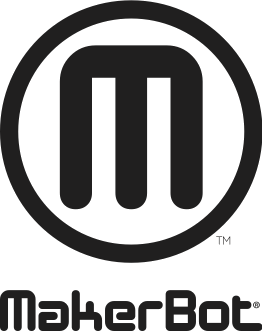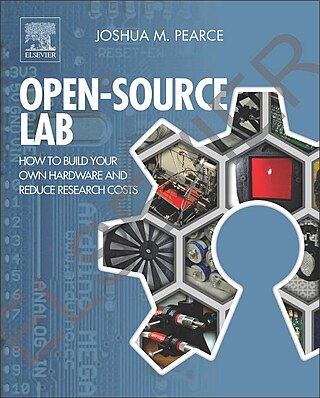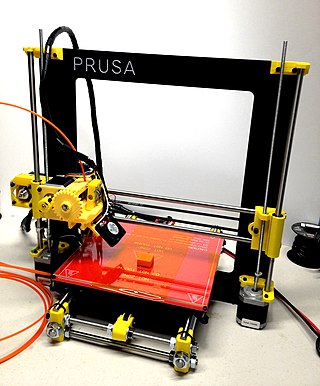
Acrylonitrile butadiene styrene (ABS) (chemical formula (C8H8)x·(C4H6)y·(C3H3N)z ) is a common thermoplastic polymer. Its glass transition temperature is approximately 105 °C (221 °F). ABS is amorphous and therefore has no true melting point.

A fab lab is a small-scale workshop offering (personal) digital fabrication.

3D printing, or additive manufacturing, is the construction of a three-dimensional object from a CAD model or a digital 3D model. It can be done in a variety of processes in which material is deposited, joined or solidified under computer control, with the material being added together, typically layer by layer.

RepRap is a project to develop low-cost 3D printers that can print most of their own components. As open designs, all of the designs produced by the project are released under a free software license, the GNU General Public License.

Recycling codes are used to identify the materials out of which the item is made, to facilitate easier recycling process. The presence on an item of a recycling code, a chasing arrows logo, or a resin code, is not an automatic indicator that a material is recyclable; it is an explanation of what the item is made of. Codes have been developed for batteries, biomatter/organic material, glass, metals, paper, and plastics. Various countries have adopted different codes. For example, the table below shows the polymer resin (plastic) codes. In the United States there are fewer, because ABS is placed with "others" in group 7.

MakerBot Industries, LLC was an American desktop 3D printer manufacturer company headquartered in New York City. It was founded in January 2009 by Bre Pettis, Adam Mayer, and Zach "Hoeken" Smith to build on the early progress of the RepRap Project. It was acquired by Stratasys in June 2013. As of April 2016, MakerBot had sold over 100,000 desktop 3D printers worldwide. Between 2009 and 2019, the company released 7 generations of 3D printers, ending with the METHOD and METHOD X. It was at one point the leader of the desktop market with an important presence in the media, but its market share declined over the late 2010s. MakerBot also founded and operated Thingiverse, the largest online 3D printing community and file repository. In August 2022, the company completed a merger with its long-time competitor Ultimaker. The combined company is known as UltiMaker, but retains the MakerBot name for its Sketch line of education-focused 3D printers.
Printrbot is a 3D printer company created by Brook Drumm in 2011 and originally funded through Kickstarter. Printrbot printers use fused deposition modelling to manufacture 3-dimensional artifacts.
Distributed manufacturing, also known as distributed production, cloud producing, distributed digital manufacturing, and local manufacturing, is a form of decentralized manufacturing practiced by enterprises using a network of geographically dispersed manufacturing facilities that are coordinated using information technology. It can also refer to local manufacture via the historic cottage industry model, or manufacturing that takes place in the homes of consumers.

Joshua M. Pearce is an academic engineer at Western University known for his work on protocrystallinity, photovoltaic technology, agrivoltaics, open-source-appropriate technology, and open-source hardware including RepRap 3D printers and recyclebots.

The Open-Source Lab: How to Build Your Own Hardware and Reduce Research Costs by Joshua M. Pearce was published in 2014 by Elsevier.
A recyclebot is an open-source hardware device for converting waste plastic into filament for open-source 3D printers like the RepRap. Making DIY 3D printer filament at home is both less costly and better for the environment than purchasing conventional 3D printer filament. In following the RepRap tradition there are recyclebot designs that use mostly 3-D printable parts.

Fused filament fabrication (FFF), also known as fused deposition modeling, or filament freeform fabrication, is a 3D printing process that uses a continuous filament of a thermoplastic material. Filament is fed from a large spool through a moving, heated printer extruder head, and is deposited on the growing work. The print head is moved under computer control to define the printed shape. Usually the head moves in two dimensions to deposit one horizontal plane, or layer, at a time; the work or the print head is then moved vertically by a small amount to begin a new layer. The speed of the extruder head may also be controlled to stop and start deposition and form an interrupted plane without stringing or dribbling between sections. "Fused filament fabrication" was coined by the members of the RepRap project to give an acronym (FFF) that would be legally unconstrained in its use.

Aleph Objects, Inc. was a small manufacturing company based in Loveland, Colorado. Their business model focused around the development of Open-source hardware for 3D printing with full support for Free and open-source software.

The Prusa i3 is a family of fused deposition modeling 3D printers, manufactured by Czech company Prusa Research under the trademarked name Original Prusa i3. Part of the RepRap project, Prusa i3 printers were called the most used 3D printer in the world in 2016. The first Prusa i3 was designed by Josef Průša in 2012, and was released as a commercial kit product in 2015. The latest model is available in both kit and factory assembled versions. The Prusa i3's comparable low cost and ease of construction and modification made it popular in education and with hobbyists and professionals, with the Prusa i3 model MK2 printer receiving several awards in 2016.

In recent years, 3D printing has developed significantly and can now perform crucial roles in many applications, with the most common applications being manufacturing, medicine, architecture, custom art and design, and can vary from fully functional to purely aesthetic applications.

A variety of processes, equipment, and materials are used in the production of a three-dimensional object via additive manufacturing. 3D printing is also known as additive manufacturing, because the numerous available 3D printing process tend to be additive in nature, with a few key differences in the technologies and the materials used in this process.

Hangprinter is an open-source fused deposition modeling delta 3D printer notable for its unique frameless design. It was created by Torbjørn Ludvigsen. The Hangprinter uses relatively low cost parts and can be constructed for around US$250. The printer is part of the RepRap project, meaning many of the parts of the printer are able to be produced on the printer itself. The design files for the printer are available on GitHub for download, modification and redistribution.

3D printing filament is the thermoplastic feedstock for fused deposition modeling 3D printers. There are many types of filament available with different properties.

A 3D printer extruder is a filament feeding mechanism used in many fused filament fabrication (FFF) 3D printers. There are several types of 3D printer extruders. A Bowden extruder is a type of extruder that pushes filament through a long and flexible PTFE (Teflon) tube to the hot end. An alternative type of extruder which is also widely used in filament 3D printers is the direct-drive extruder, which sits closer to the extruder hot end.
Material extrusion-based additive manufacturing (EAM) represents one of the seven categories of 3D printing processes, defined by the ISO international standard 17296-2. While it is mostly used for plastics, under the name of FDM or FFF, it can also be used for metals and ceramics. In this AM process category, the feedstock materials are mixtures of a polymeric binder and a fine grain solid powder of metal or ceramic materials. Similar type of feedstock is also used in the Metal Injection Molding (MIM) and in the Ceramic Injection Molding (CIM) processes. The extruder pushes the material towards a heated nozzle thanks to
















